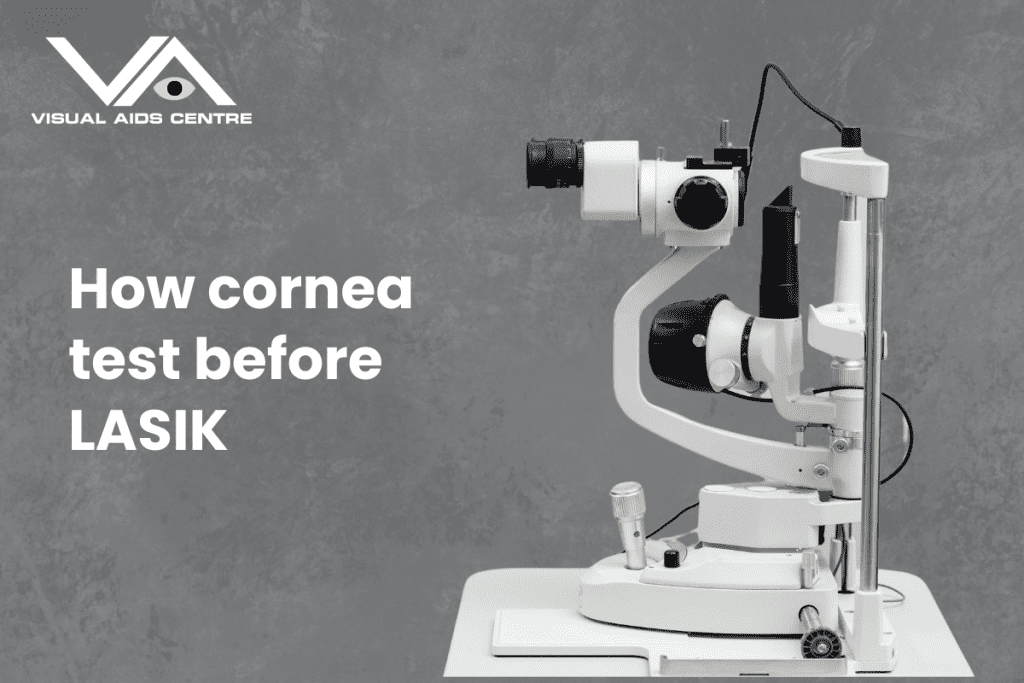Table of Contents
ToggleBefore undergoing LASIK surgery, the cornea is thoroughly tested to assess its shape, thickness, and overall health.
These tests determine whether a patient is a suitable candidate for the procedure and ensure maximum safety and effectiveness.
Understanding how the cornea is evaluated is essential for anyone considering LASIK. Each examination offers valuable insights into the eye’s structure and plays a crucial role in creating a successful surgical plan. Here’s a detailed explanation of how the cornea is tested before LASIK:

Measurement of Corneal Thickness (Pachymetry)
What is it?
The corneal thickness is measured to determine whether the cornea can withstand the reshaping required for LASIK. If the cornea is too thin, it could be unsafe to proceed with surgery.
How it’s done?
An instrument called a pachymeter is used, either in contact or non-contact form:
- Ultrasound pachymetry involves a small probe gently touching the eye.
- Optical pachymetry uses laser-based imaging for a non-invasive measurement.
Why it’s important?
Adequate corneal thickness is critical to ensure enough tissue remains after surgery to maintain corneal stability. Most surgeons look for a corneal thickness of approximately 500 microns or more.
Corneal Topography
What is it?
The topography test maps the surface of the cornea, creating a detailed 3D image of its shape and curvature. This mapping ensures that the cornea has the correct form for reshaping during LASIK.
How it’s done?
A topography machine uses light or lasers to scan the cornea. Patients are asked to focus on a specific point while the machine captures images.
Why it’s important?
- Identifies irregularities like astigmatism or keratoconus (a condition where the cornea thins and becomes cone-shaped).
- Ensures there are no abnormalities that could cause complications during or after surgery.
- Helps create a custom surgical plan for precise LASIK correction.
Corneal Biomechanics
What is it?
Corneal biomechanics testing evaluates the eye’s ability to maintain its shape and resist pressure. A strong cornea is essential for successful LASIK outcomes.
How it’s done?
The test uses devices like the Ocular Response Analyzer (ORA). It applies a light puff of air to measure how the cornea responds to force.
Why it’s important?
- Identifies weaker corneas, which may disqualify certain candidates.
- Prevents the risk of post-surgery complications like ectasia (a bulging of the cornea).
Wavefront Analysis
What is it?
This advanced diagnostic tool maps how light passes through the eye, providing insights into higher-order aberrations (minor imperfections not corrected by glasses or contact lenses).
How it’s done?
A wavefront analyser sends light into the eye and measures its return path, identifying distortions.
Why it’s important?
- Creates a precise vision correction plan tailored to an individual’s eye.
- Enhances the outcomes of LASIK by correcting even subtle visual imperfections beyond common refractive errors.
Tear Film Assessment
What is it?
The tear film is evaluated to check the quality and quantity of tears. Healthy tear production is essential for proper healing post-surgery.
How it’s done?
Non-invasive methods, such as tear breakup time (TBUT), or tests like the Schirmer test, which uses filter paper strips, are employed.
Why it’s important?
- Identifies dry eye conditions, which could worsen after LASIK.
- Ensures proper post-operative lubrication to aid recovery.
Pupil Size Measurement
What is it?
The diameter of the pupil is measured under various lighting conditions to avoid complications associated with light sensitivity or glare post-LASIK.
How it’s done?
Digital devices measure pupil size in dim and bright lighting.
Why it’s important?
- Large pupils may increase the risk of visual disturbances, especially during night driving.
- Custom LASIK treatment zones can be tailored based on pupil size.
Slit-Lamp Examination
What is it?
A slit-lamp exam examines the health of the cornea and other structures of the eye in detail.
How it’s done?
A slit lamp emits a thin beam of light while the ophthalmologist inspects your eye under magnification.
Why it’s important?
- Identifies any existing scarring, inflammation, or infections on the cornea.
- Ensures the eye is healthy enough for surgery and provides visual clarity.
Keratometry
What is it?
Keratometry measures the corneal curvature and identifies the steepness or flatness of the cornea.
How it’s done?
A keratometer is used to focus circles of light on the cornea and measure the reflected light.
Why it’s important?
- Determines astigmatism levels.
- Predicts how well your cornea can handle the reshaping process.
Optical Coherence Tomography (OCT)
What is it?
An OCT scan provides high-resolution, cross-sectional images of the cornea and other ocular structures.
How it’s done?
Using light waves, the OCT captures incredibly detailed images without touching the eye.
Why it’s important?
- Detects minor irregularities in corneal thickness or shape.
- Provides additional data for a comprehensive LASIK evaluation.
Medical History and General Eye Health
What is it?
Before LASIK, your ophthalmologist reviews your medical history, including previous eye conditions, medications, and overall health.
How it’s done?
Through a detailed discussion and a review of your eye health records.
Why it’s important?
- Ensures there are no conditions, such as autoimmune diseases, that might affect recovery.
- Determines whether previous eye surgeries or injuries could impact LASIK outcomes.
Why These Tests are Critical?
Each corneal test provides unique insights, enabling the ophthalmologist to create a highly personalised LASIK treatment plan. When combined, these evaluations ensure that LASIK is safe, effective, and tailored specifically to the patient’s needs.
Preparing for LASIK involves more than a simple eye check-up; it’s a science-backed process that prioritises your safety and vision quality.
FAQs About Corneal Testing Before LASIK
Is corneal testing painful?
No, the tests are non-invasive and cause minimal discomfort. Most tests use light or air puffs, while a few may involve gentle contact with the eye.
How long does the testing process take?
The complete corneal evaluation typically takes 1-2 hours, including preoperative counselling.
What happens if I’m not a suitable candidate for LASIK?
If LASIK isn’t suitable, your ophthalmologist will discuss alternative vision correction methods, such as PRK or implantable contact lenses.
Final Thoughts
Corneal testing before LASIK is a comprehensive and essential step in ensuring your eyes are prepared for the procedure. Each test serves to maximise safety, reduce risks, and deliver the best possible results. By thoroughly examining the cornea’s thickness, shape, tear production, and overall health, surgeons can tailor the surgery to meet your eyes’ exact needs.
If you’re considering LASIK, these tests should give you confidence that your doctor is covering every detail. Always consult a qualified ophthalmologist who invests in advanced diagnostics for better outcomes.









